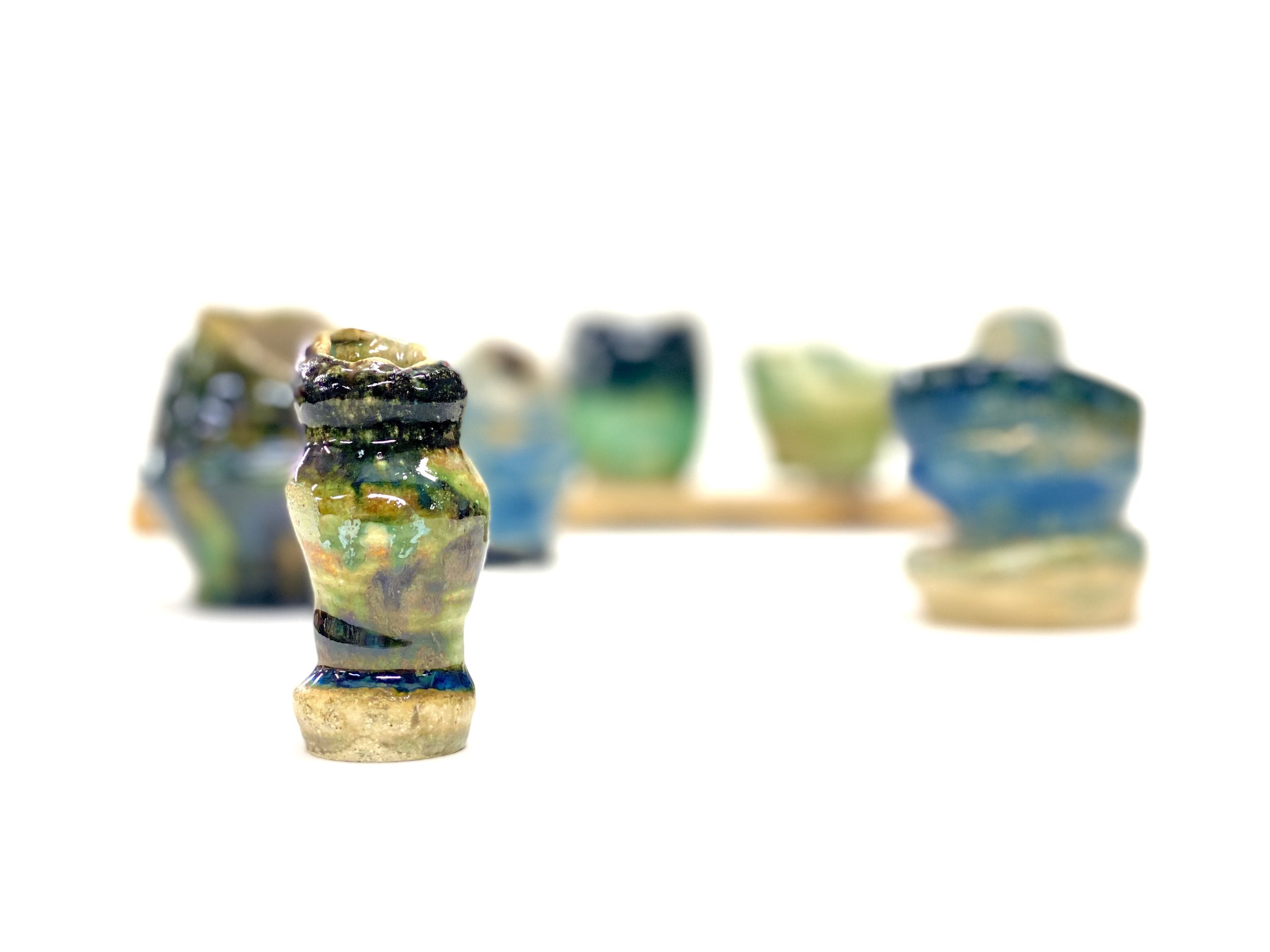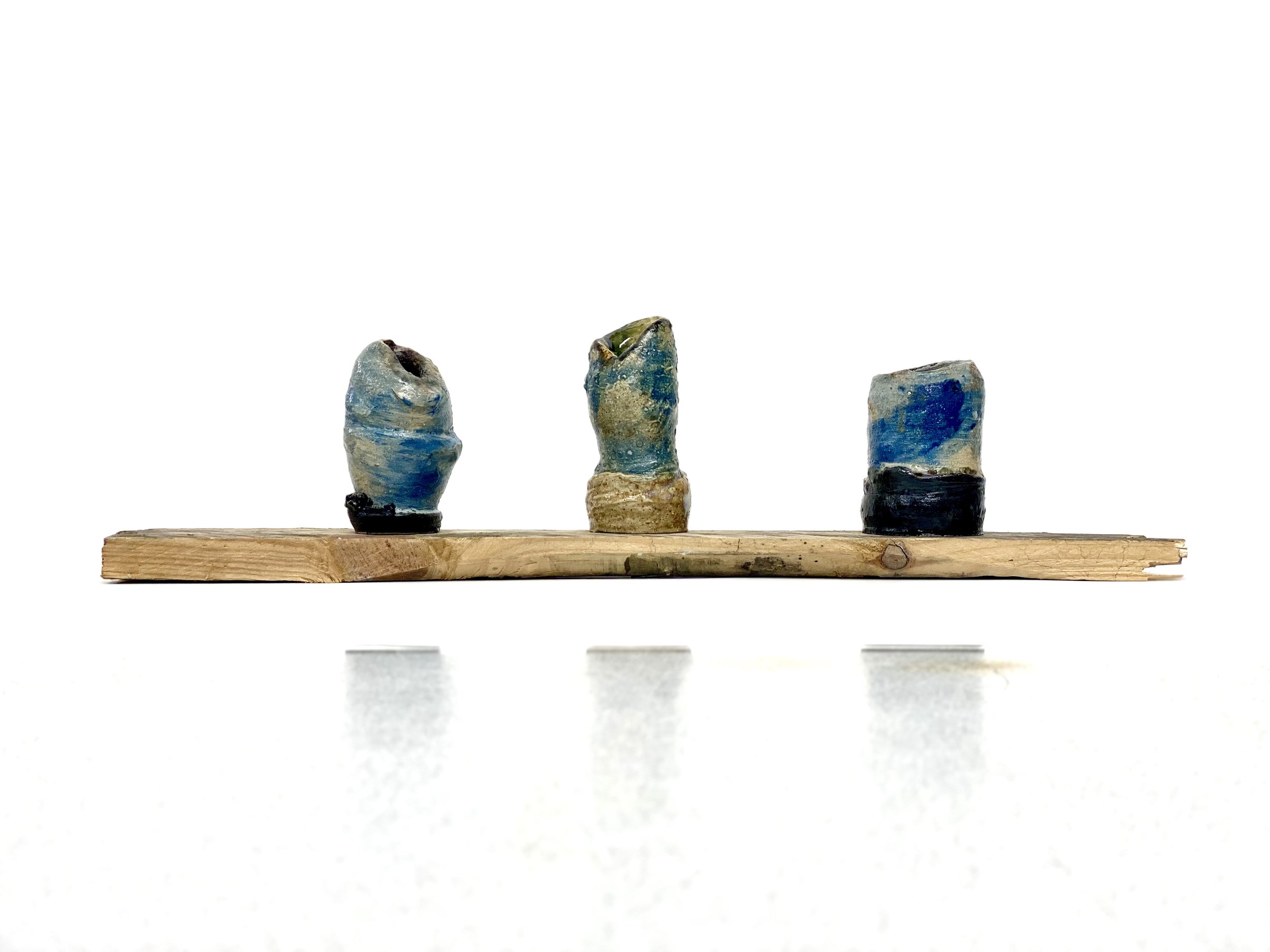Deleuzian Plateaus
The heightening of energies is sustained long enough to leave a kind of afterimage of its dynamism that can be reactivated or injected into other activities, creating a fabric of intensive states between which any number of connecting routes could exist.
A Thousand Plateaus [1]
As my practice develops over the course of this degree what has become evident is the way I approach any idea constituted through a mode of thinking that is based in a method of intuitive exploration. Vague images that develop in the minds eye are hard to visualise in the real, upon paper or just as a concept on a hard-drive. If we use the quote above as a context that encompasses all the parts of the making process, then we we get the ground as to what does and doesn’t constitute that which crosses over or transcend the act of making.
Fig. 1, Stu Lee, October 2021, Five pots from a second wave of experimental works which develop the idea of accidental properties.
Above in figure 1 are five pots that are a continuation of a developmental process in ceramics that carries over from my L5 year. When constructing the pots, it is becoming evident that they are objects that exist as a ‘thing-in-itself’.
All things that exist, exist somewhere. Whether in the mind or in the world, something will always surround or supply the means to support or act in contrast to what any one thing is being. Without getting too Heideggerdarian, we can view these objects existing outside of our own grasp-ability but acknowledge that as an artist I have a ‘response-ability’ to consider how these things may present themselves and the environment that they inhabit. What I have found, and extends upon a challenge put to me in year one, is the question of the plinth. I see these works as a way of responding to this idea of representation, tradition and innovation. If we consider the plinth then we are exploring purpose and function, place and habitat. A support if you like. Institutionally the plinth acts as basis to view work at a level, this level determines what effort we have to apply to our interaction and engagement within viewership.
In fig. 2, (right), I have tentatively explored the idea of what the plinth could be. This is a question that even this degree may not answer. There is something about the directionality of placement, when considering the separation between the base structure and the ‘terrain’ that the pottery sits on. This arbitration between final presentation and totality of the artwork as something that includes the support, for me, makes a considered attempt to think outside of the making process.
Fig. 2 , A wet cast pre-fired pottery on a purpose made ‘Plinth’
Fig. 3, Three of my ‘Accidental Properties series are placed on a plank of wood.
These works act politically as well as aesthetically. They demonstrate the positions and elevations of status and being. The representation of solidity and togetherness is captured in the bringing together like-minded materials. Wood and concrete work together well. Both materials have been instrumental in the housing of ideas and institutions. The re-purposing of wood and concrete creates an environment where ideas embodied in the making take a hierarchical stand-point when one part of the terrain lifts the work to another level. This also connects my work to the monumental also.
An extreme example would be Nelson’s column, think how your head forced to strain back to take in the view. Moving beyond typical modes of engagement force us to re-evaluate the hierarchy of placement and what advantages are embodied in such processes. This is where I think the introductions of “plateaus” will add a dynamic that re-activate a new world for these ceramics to exist. Hopefully under their own terms. I have taken the idea of territory from the book A Thousand Plateaus: Capitalism and Schizophrenia. In the chapter Apparatus of Capture Deleuze and Guattari, explain how territory, as object, gives rise to hegemonic structures that capture what it is to exist in a networked systems that embody polarized social formations. Upon thinking about environment and residency for object forms, this work is seriously fused, as a concept, by the bringing together levels, structures and objects.
It operates by stratification; in other words, it forms a vertical, hierarchized aggregate that spans the horizontal lines in a dimension of depth. In retaining given elements, it necessarily cuts off their relations with other elements, which become exterior, it inhibits, slows down, or controls those relations; if the State has a circuit of its own, it is an internal circuit dependent primarily upon resonance, it is a zone of recurrence that isolates itself from the remainder of the network, even if in order to do so it must exert even stricter controls over its relations with that remainder. [2]
Objects, without careful consideration, take on the form of what exist outside, yet at the same time exist within specific structures and apparatus. There is not only an external coexistence of formations but also an intrinsic coexistence of machinic processes. In other words, my involvement as the maker is only a small part of the totality of what is to be “found” in the work. Whether political or aesthetic, the evolution of an idea demonstrably has a basis in making as research. This show a confidence in the way I choose to execute ideas and allow my trust in the potential of the materials to produce something with me not because of me, is a real success in itself.
[1] Deleuze, Gilles, Guattari, Felix, A Thousand Plateaus, (London: Althorn Press, 1988), p. xii-xiii
[2] Ibid. p. 434



